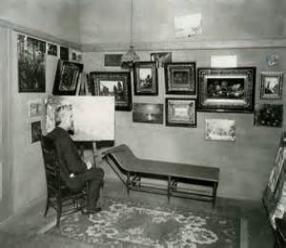Levi Wells Prentice NEW

Gallery Database:
Levi Wells Prentice (1851 - 1935). "Adirondack
Farms," ca. 1885, oil on canvas, 20 x 24, signed.
High-quality reproduction frame.
PRENTICE PAINTS
AMERICAN PRIMITIVE!
Curator's Comment:
Noted American art scholar Bill Gerdts calls what Levi Wells Prentice did best 'illiusionism.' Gerdts should know because his still-life collection featured a major work by Prentice. Others refer to Prentice's style as a proto trompe l'oeil--the French art term for 'fools the eye'--we call it simply 'primitive.' But note that the only scholarly study of Prentice is Nature Staged by Barbara L. Jones, whose use of the term 'staged' is apt indeed. We think his unique style is simply 'Landscape as Still Life'--and as landscape collectors we long wanted to own an example of his work. We've been told by one Antiques Roadshow curator that you buy Prentice for his still life's only--'especially his apples.' But there is just nothing like his frozen portraits of the Adirondacks that he wandered through in his youth--teaching himself how to paint while reading Ruskin on Renaissance Art and Modern Painters.

The Artist in his Brooklyn Studio

A Hatful of Apples brought $135,000
Prentice was born in Lewis County, New York in 1851 and raised on a small farm in the Adirondack Mountains. He painted landscapes as far afield as Buffalo and Syracuse, where he established his first studio. A few early portraits have survived, which suggest Prentice may have seen work by Erastus Field. He married an English woman, Emma Roseloe Sparks, in Buffalo, New York in 1882 and in 1883, he moved to Brooklyn, New York, where he worked as a carpenter and art teacher. Newman Galleries employed Prentice as a framemaker. He was a member of the Brooklyn Art Association and frequently exhibited as such. This was the period of his masterpiece still-life studies of fruit on the table, in hats, or baskets. Prentice emphasizes American abundance, with overflowing--apples, strawberries, peaches, plums, raspberries, cherries, muskmelons, pears, currants, pineapples, gooseberries, and grapes--all piled high in kitchens or in natural settings. And the contrast between the basket work and the actual fruit has caused some to see Prentice as distinguishing the works of man and nature. But we think he is telling us about the land of plenty. That is the dominant theme of his settings, be they tabletops full of one cake after another or the baskets and hats that are always spilling over. Nature is generous and its fecundity easily overcomes time as the artist struggles to survive mutability much in the way of Keats's Odes. By illusionism, Gerdts meant that Prentice's still-life fruits are in fact good enough to eat--their chiaroscuro rendition and waxy polished surfaces are intended to make the viewer say grace for nature's gifts.

